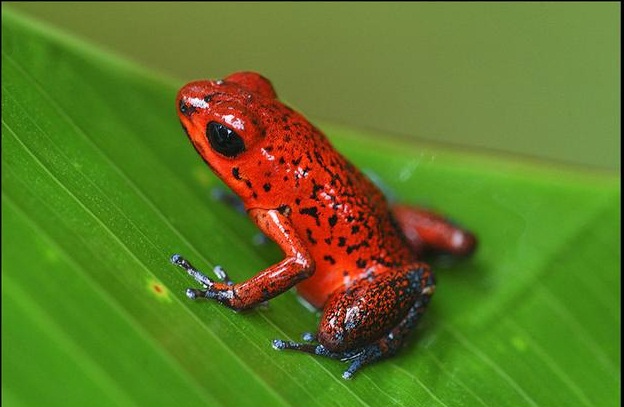Costa Rica Nature Continues to Amaze – New study reveals unique habits of Poison Dart Frogs
We all know that being a mother can be a tough job and Costa Rica wildlife is no exception. For the female Strawberry Poison Dart Frog in Costa Rica, feeding its offspring is no normal routine.
Click here and book your stay at one of our beautiful jungle villas!

Contrasting with the image of little amphibians jumping from one lily pad to the next, the poison dart frogs are far more bold and dangerous than their green cousins. At only 2.5 cm long, these incredible amphibians secrete a poison from glands located on their back. This poison was traditionally used by indigenous tribes for use on the tips of darts or arrows for hunting.
Costa Rica Nature – The Blue Jean Frog
The posion dart frogs are so rare they are in danger of extinction. For U.S biologist Jennifer Stynoski, the Strawberry Poison Dart frog or the ‘Blue Jean Frog’ as its commonly known, due to its bright red body and blue legs, is actually an extremely fragile creature that has an extraordinary reproduction strategy. The findings of a recent study carried out by Stynoski at the Organization of Tropical Studies in Costa Rica (OTS), reveals that the female Blue Jean Frog feeds its tadpoles with her unfertilized eggs. She feeds her young, which develop in pools in bromeliad leaves, by memorizing their location.
For a period of six weeks, mothers return every two days to feed their unfertilized eggs to their offspring. Stynoski notes that “the production of eggs is considerable, considering that each mother has various tadpoles to look after”. In addition, mothers whose tadpoles were replaced by strangers still feed them at the original site, as if they were their own biological “children”. Enamored by the
Catch a glimpse at the Arenal Volcano
For those arriving to Costa Rica and want to catch a glimpse of such wonderful amphibians, keep a look out in the lowland wet forests such as the Tortuguero, Arenal Volcano and Parque Nacional La Selva. Active during the day, the Blue Jean Frog reproduces all year long in areas without a long dry season. You will know if you are getting close to these amazing frogs through hearing the sound of buzzing and chirping males that are attracting potential mates.

 +1 888-818-2097
+1 888-818-2097
 +506 8932-4731
+506 8932-4731